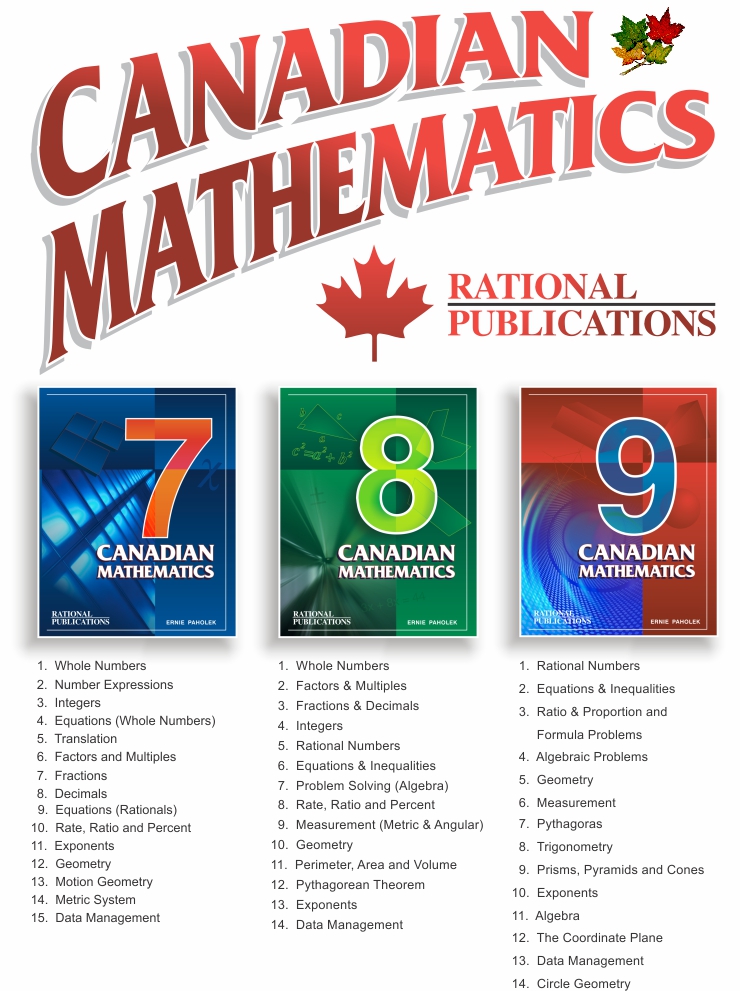| |







|
THEY’RE READY FOR YOUR CLASSROOM
The newly revised Canadian Mathematics 7-8-9 series meets and even exceeds your current and changing provincial curriculum guidelines. See links for the revisions and additions.

|
|
|
|
|
 |
|
 |
|
The CANADIAN MATHEMATICS 7 - 8 - 9 series has been recognized as one of the best mathematics series in Canada today. Author Ernie Paholek received the Prime Minister's Award for Teaching Excellence in Science, Technology and Mathematics for his work in writing and producing these books. This series of mathematics books is consistent with all provincial curriculums and can be used as either a primary or supplementary resource by regular, advanced or even remedial students.
This series is a combination of a text-book, a reference-book, a work-book and even a scribbler. Each books contains examples, definitions, diagrams, charts, illustrations and even cartoons and is the best and most affordable mathematics series in Canada today that actually prepares your students for grade 10 mathematics. The books are a comprehensive study of mathematics for grades 7, 8 and 9 mathematics classes. You will find that each book is very 'user friendly' for you the teacher, your students, and also your students' parents. (The examples, diagrams and explanations are very easy to follow and even parents who have forgotten how to do junior high math can quickly understand the concepts and help their children at home if necessary.) Emphasis is placed on word problems, review exercises and traditional 'problem areas'. Your students' and parents' understanding and appreciation of mathematics will most certainly improve.
If you would like to purchase single copies or class sets of these books, an order form is included on the back page. If you decide not to order class sets, the copyright waiver allows you to photocopy portions or all of the books for one school year.
|
|
|
 |
|
|
 |
|
 |
|
1. Number Systems & Operations
A student entering grade 7 will be reviewing the four basic operations of adding subtracting, multiplying and dividing of whole numbers. Fractions and decimals will be introduced. Students at this grade level will also study the order in which operations are done and use this knowledge for computations involving whole numbers, fractions and decimals. At the grade eight level the students' knowledge should be expanded to include computation and order of operations including rational numbers, exponents and percentages. At the grade nine level students should be ready to handle expressions with negative exponents, scientific notation and square roots in preparation for the mathematics they will be exposed to in grade ten.
2. Mathematical Procedures and Processes
One of the key things in the study of grade seven mathematics is the students' ability to estimate an answer with whole number, fractions, decimals and integers before actually working out a question. This shows true understanding of any concept. By grade eight a student should be able to use his/her estimations skills to include rational numbers and by grade nine we can include exponents and square roots to this list. The use of a calculator and calculator procedures is a must for students in this day and age and we must ensure that all our students are competent and comfortable using a calculator.
3. Geometry and Measurement
All calculations involving measurement and geometry use the SI system. In grade seven calculating perimeter and areas of simple figures, whether by measuring or by using a simple formula, is a must. Motion geometry, scale drawings and scale ratio are also included in the grade seven course. By grade eight, students are exposed to angles, triangles, quadrilaterals, polygons, etc. and should be able to calculate area and perimeter of each. Pythagoras is also now included in the grade 8 book. In the grade nine book we have included mathematical constructions, trigonometry, volume, capacity, mass and graphing.
|
|
|
 |
|
|
 |
|
|
4. Algebra, Functions and Patterns
In the grade seven book we have introduced the idea of constants and variables (boxes, circles, etc.) and then letters, whereby the students substitute to obtain the answer. Positive ordered pairs (coordinates) are introduced and then graphed. In grade eight the degree of difficulty increases and functions with positive and negative coordinates are used to draw linear graphs. At the grade nine level we have expanded this to include parabolas and hyperbolas. The exponent laws are introduced using variables, as is adding, subtracting, multiplying and dividing polynomials. We have included common factoring, grouping, difference of squares and trinomial factoring as part of the grade nine course. The more advanced student can work with rational expressions.
5. Data Analysis, Statistics and Probability
In grade seven we have the students interpreting and drawing bar graphs, line graphs, circle graphs and also plotting ordered pairs. At the grade eight level we introduce the mean, median and mode. At the grade nine level we have increased this to also include probability.
|
|
|
|
|
|
|
|
|
Also Available

Math 7 | Math 8 | Math 9 | Order Form | Contact Us
|
|












